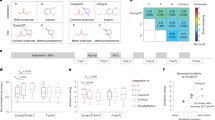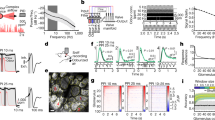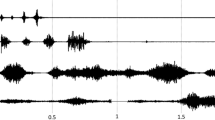Abstract
Inhaled vapours may stimulate both olfactory receptor cells and endings of the trigeminal nerve1. The trigeminal nerve often contributes a pungent, irritating attribute to odours. Many odorants exhibit some pungency when dilute and most become pungent when concentrated2 Because the trigeminal system commonly shares the chemosensory burden with olfaction, it is relevant to ask whether these anatomically distinct systems interact3–6. Two obscure psychophysical observations argue for an inhibitory influence of trigeminal over olfactory activity. Katz and Talbert observed that a vapour with both odour and pungency might lose odour at high concentrations, irritation masking odour7. The nineteenth century philosopher Alexander Bain, noting that concentrated carbon dioxide (carbonic acid) evokes pungency, remarked “if a current of carbonic acid accompanies an odour, the effect (odour) is arrested” (ref. 8). We have taken up Bain's forgotten observation and used carbon dioxide to endow otherwise benign concentrations of odorant with varying degrees of pungency. The experiments reported here reveal a strong mutual interaction between pungency and odour, occurring without attenuation even when irritant enters one nostril and odorant the other.
This is a preview of subscription content, access via your institution
Access options
Subscribe to this journal
Receive 51 print issues and online access
$199.00 per year
only $3.90 per issue
Buy this article
- Purchase on Springer Link
- Instant access to full article PDF
Prices may be subject to local taxes which are calculated during checkout
Similar content being viewed by others
References
Tucker, D. in Handbook of Sensory Physiology Vol. VI, pt 1 (ed. Beidler, L. M.) 151–181 (Springer, Berlin, 1971).
Cain, W. S. Ann. N. Y. Acad. Sci. 237, 28–34 (1974).
Stone, H., Carregal, E. J. & Williams, B. Life Sci. 5, 2195–2201 (1966).
Stone, H., Williams, B. & Carregal, J. A. Expl Neurol. 21, 11–19 (1968).
Stone, H. in Olfaction and Taste III (ed. Pfaffmann, C.) 216–220 (Rockefeller University Press, New York, 1969).
Stone, H. & Rebert, C. S. Brain Res. 21, 138–142 (1970).
Katz, S. H. & Talbert, E. J. Tech. Pap. 480 (Bureau of Mines, US Department of Commerce, 1930).
Bain, A. The Senses and the Intellect, 152 (Longmans Green, London, 1868).
Cain, W. S. & Moskowitz, H. R. in Human Responses to Environmental Odors (eds Turk, A., Johnston, J. W. Jr & Moulton, D. G.) 1–32 (Academic, New York, 1974).
Cain, W. S. Nature 268, 50–52 (1977).
Tucker, D. in Olfaction and Taste (ed. Zotterman, Y.) 45–69 (Pergamon, London, 1963).
Cain, W. S. Sensory Processes 1, 57–67 (1976).
Hughes, J. R. & Mazurowski, J. A. Electroenceph. clin. Neurophysiol. 14, 646–653 (1962).
Sem-Jacobsen, C. W. et al. Am. J. med. Sci. 232, 243–251 (1956).
Walsh, R. R. Am. J. Physiol. 186, 255–257 (1956).
Author information
Authors and Affiliations
Rights and permissions
About this article
Cite this article
Cain, W., Murphy, C. Interaction between chemoreceptive modalities of odour and irritation. Nature 284, 255–257 (1980). https://doi.org/10.1038/284255a0
Received:
Accepted:
Issue Date:
DOI: https://doi.org/10.1038/284255a0
This article is cited by
-
Linalool odor‐induced analgesia is triggered by TRPA1-independent pathway in mice
Behavioral and Brain Functions (2021)
-
Chemosensory decrease in different forms of olfactory dysfunction
Journal of Neurology (2020)
-
Assessment of taste functions in allergic rhinitis patients undergoing allergen-specific immunotherapy
European Archives of Oto-Rhino-Laryngology (2019)
-
Temporal Encoding During Unimodal and Bimodal Odor Processing in the Human Brain
Chemosensory Perception (2019)
-
Neuropeptides in sensory signal processing
Cell and Tissue Research (2019)
Comments
By submitting a comment you agree to abide by our Terms and Community Guidelines. If you find something abusive or that does not comply with our terms or guidelines please flag it as inappropriate.



